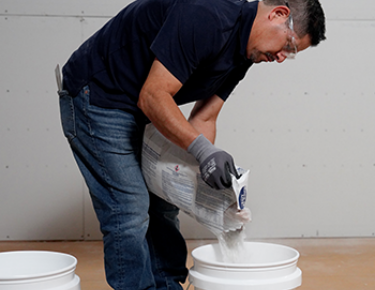 Building Knowledge
Building Knowledge
Matching the ideal joint compound with the appropriate finishing tool
Ensure a smooth, high-quality finish with ProForm joint compounds

When it comes to using both automatic and hand drywall tools, finding a joint compound that works best with each can significantly improve the efficiency and effectiveness of the finishing process.
ProForm Finishing Products, LLC, an affiliate of National Gypsum Company, manufactures a full line of interior ready mix joint compounds across its five U.S. manufacturing plants. Whether it's lighter weight mud that minimizes fatigue when finishing by hand or joint compounds that work with automatic tools, such as drywall banjos and drywall bazookas, ProForm has the right solution for every application.
What ProForm products work best for finishing by hand?
From taping and drywall knives to trowels and mud pans, handheld drywall finishing tools are a popular choice for applying joint compound, smoothing seams and creating texture. Finding a drywall joint compound that is lighter in weight and easier to spread can alleviate wear and tear on the drywall finisher’s hands, arms and shoulders.
ProForm® Lite Blue® Joint Compound is approximately 30% lighter than conventional ProForm joint compound. Offering easier pull — meaning it spreads with less effort for quick application — Lite Blue Joint Compound is designed for use in finishing gypsum board joints, spotting fasteners and finishing corner beads.
ProForm® Ultra Lite® All Purpose Joint Compound is an innovative product that is approximately 40% lighter than other conventional all-purpose ready mix products and is ideal for all phases of finishing.
What ProForm products work best with automatic finishing tools?
Automatic drywall tools help improve efficiency and ensure consistency when taping and finishing drywall joints. Three popular tools are the drywall banjo, the drywall bazooka (also known as an automatic taper) and the drywall box (specifically, the flat box).
ProForm® All Purpose Machine Grade Joint Compound is designed for use in mechanical taping and finishing tools, including banjos, bazookas and boxes. Available in the mid-Atlantic and Southeast areas of the United States, Machine Grade Joint Compound is formulated with a modified viscosity to run more smoothly through these automatic taping and finishing tools.
ProForm® Taping Lite Joint Compound is 40% lighter than standard taping compounds and is ideal for use with both banjo and bazooka automatic finishing tools. Available in the Central and Midwest regions of the U.S., Taping Lite provides an excellent adhesion/bond.
ProForm Ultra Lite All Purpose Joint Compound is ideal for all phases of finishing and can be used with banjo, bazooka and box automatic finishing tools. Available nationwide, Ultra Lite is a great option for jobs requiring both hand and automatic finishing tools.
Note: ProForm setting compounds should never be used in any automatic finishing tools. These dry-mix compounds will jam machines if used and are difficult to clean out of tools.
Usage tips for automatic finishing tools
Using automatic finishing tools effectively can significantly speed up the drywall finishing process while ensuring high-quality results. Proper cleaning and maintenance are essential to keep each in good working condition.

1. Drywall banjo
The drywall banjo is a handheld tool used for applying joint compound and tape to drywall seams simultaneously. To use it, fill the banjo with joint compound, load a roll of drywall tape and thread the tape through the applicator. As you pull the tape, the banjo coats it with joint compound and applies it to the seam.
Usage tips*
- Adjust the amount of joint compound applied to the tape by altering the tool's tension or the compound’s thickness.
- Practice on scrap drywall to get a feel for the right speed and pressure.
- Clean the banjo immediately after use to prevent the joint compound from hardening.
- Disassemble the tool and rinse all parts with water, using a brush to remove any residue.
2. Drywall bazooka
The drywall bazooka, or automatic taper, is a more advanced tool that applies both the joint compound and the tape to drywall seams in one step. The user fills the bazooka with joint compound, loads a roll of tape and feeds the tape through the machine. As they move the bazooka along the seam, it applies the tape and compound, cutting the tape automatically at the end of the seam.
Usage tips*
- Ensure the compound is mixed to the right consistency to flow smoothly through the taper.
- Keep the tool clean and well-maintained to avoid jams and ensure smooth operation.
- Disassemble the bazooka and thoroughly clean all parts with water and a brush.
- Pay attention to the internal mechanisms and moving parts to prevent compound buildup.
3. Drywall box
The drywall (flat) box is a finishing tool, rather than an initial taping tool, and is used to apply a smooth, even layer of joint compound over taped seams and to feather the edges. It is often used after the initial taping to apply subsequent coats of compound. The user fills the box with compound, and as it moves along the seam, it dispenses the compound evenly, smoothing it out with a built-in blade.
Usage tips*
- Adjust the blade and pressure settings according to the thickness of the compound and the desired finish.
- Use a consistent, steady motion to avoid lines or ridges in the compound.
- Clean the box immediately after use to prevent the compound from hardening inside.
- Disassemble and rinse all parts thoroughly, using a brush to clean the blade and interior.
Experience the ProForm difference

In addition to providing options for both hand and automatic drywall tools, ProForm also manufactures seven types of ready mix joint compound formulated to regional preferences to complement its nationally distributed ready mix joint compounds.
Explore the ProForm Construction Guide to learn more about ProForm’s complete line of both ready mix and setting joint compounds, along with related finishing products such as joint tape and texture products.
*Always check the manufacturer’s instructions for specific usage, maintenance and cleaning guidelines
Be the first to hear of new NGConnects blog posts by subscribing here for early access.
Related Blog Posts

How to choose the right ready mix joint compound
See which joint compounds work well regardless of the level of fi...
Read MoreRelated Podcasts

Episode 4: Understanding the ratings behind acoustical wall, ceiling and roof assemblies
Familiarize yourself with STC, IIC, CAC and OITC rating classes a...
Listen Now










